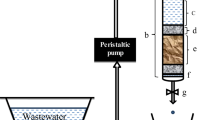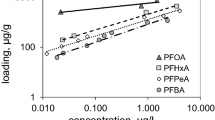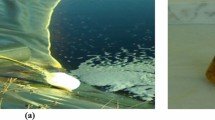Abstract
Background, aim, and scope
Chlorinated volatile organic compounds (CVOCs), widely used in industry as solvents and chemical intermediates in the production of synthetic resins, plastics, and pharmaceuticals, are highly toxic to the environment and public health. Various studies reported that Fenton’s oxidation could degrade a variety of chlorinated VOCs in aqueous solutions. In acidic conditions, ferrous ion catalyzes the decomposition of H2O2 to form a powerful •OH radical. In this study, wastewater from wash of ion-exchange resin containing typical CVOC, 1,2-dichloroethane, was treated using Fenton’s oxidation. To reduce environmental load and processing costs of wastewater, Fenton process as a simple and efficient treatment method was applied to degrade 1,2-dichloroethane of wash water.
Materials and methods
The water samples were collected from three different washing stages of ion-exchange resin. The degradation of 1,2-dichloroethane and total organic carbon (TOC) of wash water of ion-exchange resin by Fenton process was studied with response surface method (RSM). Design of the experiments was conducted by central composite face, and factors included in three models were Fe2+ and H2O2 doses and treatment time. Relevant quadratic and interaction terms of factors were investigated.
Results
According to ANOVA, the model predicts well 1,2-dichloroethane reduction of all water samples and TOC reduction of samples 2 and 3. The Fe2+ and H2O2 doses used in the present study were most suitable when 1,2-dichloroethane concentration of the wash water is about 120 mg L−1. In that case, Fenton’s oxidation reduced 1,2-dichloroethane and TOC up to 100% and 87%, respectively, according to the RSM model. With 90-min reaction time and H2O2 dose of 1,200 mg L−1, the required Fe2+ doses for 1,2-dichloroethane and TOC were 300 and 900 mg L−1, respectively. The optimal H2O2/Fe2+ stoichiometric molar ratio was between 4–6. Then, concentration of Fe2+ was low enough and the amount of residual sludge can thus be reduced. It seems that most of TOC and part of 1,2-dichloroethane were removed by coagulation.
Discussion
Up to a certain extent, increase of Fe2+ and H2O2 doses improved the removal of 1,2-dichloroethane and TOC. High Fe2+ doses increased the formation of ferric-based sludge, and excessive H2O2 doses in sample 2 decreased the degradation of 1,2-dichloroethane. Excess amount of hydrogen peroxide may scavenge hydroxyl radicals, thus leading to loss of oxidative power. Also, the residual hydrogen peroxide of different samples increased with increasing H2O2 dose and H2O2/Fe2+ molar ratio and decreasing treatment time probably also due to scavenging reactions. Due to the saturated nature of 1,2-dichloroethane, the oxidation mechanism involves hydrogen abstraction before addition of hydroxyl radical, thus leading to lower rate constants than for direct hydroxyl radical attack, which for one increases the treatment time.
Conclusions
Complete removal of 1,2-dichloroethane was attained with initial concentration <120 mg L−1. Also, TOC degraded effectively. Wash water with higher concentration of 1,2-dichloroethane requires longer treatment times and higher concentrations of Fe2+ and H2O2 for sufficient 1,2-dichloroethane removal.
Recommendations and perspectives
Due to the results achieved in this study, Fenton’s oxidation could be recommended to be used for organic destruction of wash water of ion-exchange resin. Residual sludge, the main disadvantage in Fenton process, can be reduced by optimizing the ferrous dose or by using heterogeneous treatment where most of the reusable iron remains in the solid phase.




Similar content being viewed by others
References
Badawy MI, Ali MEM (2006) Fenton’s peroxidation and coagulation processes for the treatment of combined industrial and domestic wastewater. J Hazard Mater B136:961–966
Benatti CT, Granhen Tavares CR, Guedes TA (2006) Optimization of Fenton’s oxidation of chemical laboratory wastewaters using the response surface methodology. J Environ Manag 80:66–74
Chen G, Hoag GE, Chedda P, Nadim F, Woody BA, Dobbs GM (2001) The mechanism and applicability of in situ oxidation of trichloroethylene with Fenton’s reagent. J Hazard Mater B87:171–186
Devine JS, Wieland HL (1992) Onsite pilot testing of UV-enhanced oxidation and chemical oxidation by Fenton’s reagent. In Air & Waste Management 85th Annual Meeting & Exhibition, Kansas City, Missouri, June 21–26, 1992
Gogate PR, Pandit AB (2004a) A review of imperative technologies for wastewater treatment I: oxidation technologies at ambient conditions. Adv Environ Res 8:501–551
Gogate PR, Pandit AB (2004b) A review of imperative technologies for wastewater treatment II: hybrid methods. Adv Environ Res 8:553–597
Grčić I, Vujević D, Šepčić J, Koprivanac N (2009) Minimization of organic content in simulated industrial wastewater by Fenton type processes: a case study. J Hazard Mater 170:954–961
Janda V, Vasek P, Bizova J, Belohlav Z (2004) Kinetic models for volatile chlorinated hydrocarbons removal by zero-valent iron. Chemosphere 54:917–925
Kang YW, Hwang K-Y (2000) Effects of reaction conditions on the oxidation efficiency in the Fenton process. Water Res 34:2786–2790
Kastanek F, Maleterova Y, Kastanek P, Rott J, Jiricny V, Jiratova K (2007) Complex treatment of wastewater and groundwater contaminated halogenated organic compounds. Desalination 211:261–271
Kurniawan TA, Lo W-H, Chan GYS (2006) Radicals-catalyzed oxidation for degradation of recalcitrant compounds from landfill leachate. Chem Eng J 125(1):35–57
Kušić H, Lončarić Božić A, Koprivanac N (2007) Fenton type processes for minimization of organic content in coloured wastewaters: Part I: process optimization. Dyes Pigments 74:380–387
Lal M, Schöneich C, Mönig J, Asmus K-D (1988) Rate constants for the reactions of halogenated organic radicals. Int J Radiat Biol 54:773–785
Lindsey ME, Tarr MA (2000) Quantitation of hydroxyl radical during Fenton oxidation following a single addition of iron and peroxide. Chemosphere 41:409–417
Lopez A, Pagano M, Volpe A, Di Pinto AC (2004) Fenton’s pre-treatment of mature landfill leachate. Chemosphere 54:1005–1010
Munter R (2001) Advanced oxidation processes—current status and prospects. Proc Estonian Acad Sci Chem 50:59–80
Musialik-Piotrowska A, Mendyka B (2004) Catalytic oxidation of chlorinated hydrocarbons in two-component mixtures of selected VOCs. Catal Today 90:139–144
Myers R, Montgomery D (2002) Response surface methodology: process and product optimization using designed experiments, 2nd edn. Wiley, New York
Neyens E, Baeyens J (2003) A review of classic Fenton’s peroxidation as an advanced oxidation technique. J Hazard Mater 98:33–50
Pignatello JJ, Oliveros E, MacKay A (2006) Advanced oxidation processes for organic contaminant destruction based on the Fenton reaction and related chemistry. Crit Rev Env Sci Tec 36:1–84
Seol Y, Javandel I (2008) Citric acid-modified Fenton’s reaction for the oxidation of chlorinated ethylenes in soil solution systems. Chemosphere 72:537–542
Sun J-H, Sun S-P, Fan M-H, Guo H-Q, Qiao L-P, Sun R-X (2007) A kinetic study on the degradation of p-nitroaniline by Fenton oxidation process. J Hazard Mater 148:172–177
Tang WZ, Huang CP (1997) Stochiometry of Fenton’s reagent in the oxidation of chlorinated aliphatic organic pollutants. Environ Technol 18:13–23
Tang WZ, Tassos S (1997) Oxidation kinetics and mechanisms of trihalomethanes by Fenton’s reagent. Water Res 31(5):1117–1125
Teel AL, Warberg CR, Atkinson DA, Watts RJ (2001) Comparison of mineral and soluble iron Fenton’s catalysts for the treatment of trichloroethylene. Water Res 35(4):977–984
Vilhunen S, Vilve M, Vepsäläinen M, Sillanpää M (2009) Removal of organic matter from a variety of water matrices by UV photolysis and UV/H2O2 method. Manuscript
Walling C (1975) Fenton’s reagent revisited. Acc Chem Res 8:125–131
Zhang H, Choi HJ, Canazo P, Huang C-P (2009) Multivariate approach to the Fenton process for the treatment of landfill leachate. J Hazard Mater 161:1306–1312
Acknowledgment
The financial support from EU, City of Mikkeli and Finex Oy is gratefully acknowledged. The authors thank the European Commission (EC) for the Marie Curie Fellowship for transfer of knowledge (no. MTKD-CT-2006-042637).
Author information
Authors and Affiliations
Corresponding author
Additional information
Responsible editor: Ake Bergman
Rights and permissions
About this article
Cite this article
Vilve, M., Vilhunen, S., Vepsäläinen, M. et al. Degradation of 1,2-dichloroethane from wash water of ion-exchange resin using Fenton’s oxidation. Environ Sci Pollut Res 17, 875–884 (2010). https://doi.org/10.1007/s11356-009-0291-5
Received:
Accepted:
Published:
Issue Date:
DOI: https://doi.org/10.1007/s11356-009-0291-5




